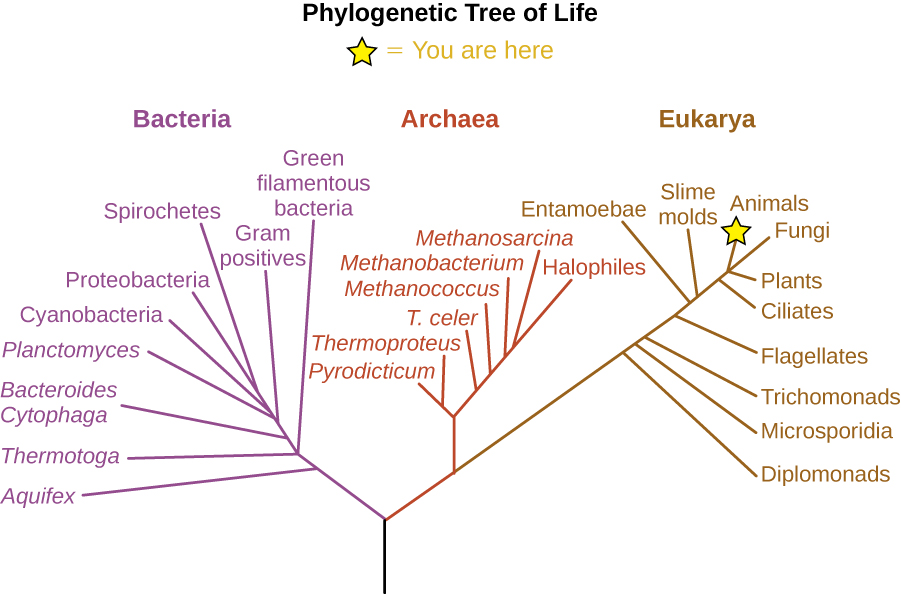| << Chapter < Page | Chapter >> Page > |
In the 1970s, American microbiologist Carl Woese discovered what appeared to be a “living record” of the evolution of organisms. He and his collaborator George Fox created a genetics-based tree of life based on similarities and differences they observed in the small subunit ribosomal RNA (rRNA) of different organisms. In the process, they discovered that a certain type of bacteria , called archaebacteria (now known simply as archaea ), were significantly different from other bacteria and eukaryotes in terms of the sequence of small subunit rRNA. To accommodate this difference, they created a tree with three Domains above the level of Kingdom: Archaea, Bacteria, and Eukarya ( [link] ). Genetic analysis of the small subunit rRNA suggests archaea, bacteria, and eukaryotes all evolved from a common ancestral cell type. The tree is skewed to show a closer evolutionary relationship between Archaea and Eukarya than they have to Bacteria.

Scientists continue to use analysis of RNA, DNA, and proteins to determine how organisms are related. One interesting, and complicating, discovery is that of horizontal gene transfer—when a gene of one species is absorbed into another organism’s genome. Horizontal gene transfer is especially common in microorganisms and can make it difficult to determine how organisms are evolutionarily related. Consequently, some scientists now think in terms of “webs of life” rather than “trees of life.”
In developing his taxonomy, Linnaeus used a system of binomial nomenclature , a two-word naming system for identifying organisms by genus and species. For example, modern humans are in the genus Homo and have the species name sapiens , so their scientific name in binomial nomenclature is Homo sapiens . In binomial nomenclature, the genus part of the name is always capitalized; it is followed by the species name, which is not capitalized. Both names are italicized.
Taxonomic names in the 18th through 20th centuries were typically derived from Latin, since that was the common language used by scientists when taxonomic systems were first created. Today, newly discovered organisms can be given names derived from Latin, Greek, or English. Sometimes these names reflect some distinctive trait of the organism; in other cases, microorganisms are named after the scientists who discovered them. The archaeon Haloquadratum walsbyi is an example of both of these naming schemes. The genus, Haloquadratum , describes the microorganism’s saltwater habitat ( halo is derived from the Greek word for “salt”) as well as the arrangement of its square cells, which are arranged in square clusters of four cells ( quadratum is Latin for “foursquare”). The species, walsbyi , is named after Anthony Edward Walsby, the microbiologist who discovered Haloquadratum walsbyi in in 1980. While it might seem easier to give an organism a common descriptive name—like a red-headed woodpecker—we can imagine how that could become problematic. What happens when another species of woodpecker with red head coloring is discovered? The systematic nomenclature scientists use eliminates this potential problem by assigning each organism a single, unique two-word name that is recognized by scientists all over the world.

Notification Switch
Would you like to follow the 'Microbiology' conversation and receive update notifications?